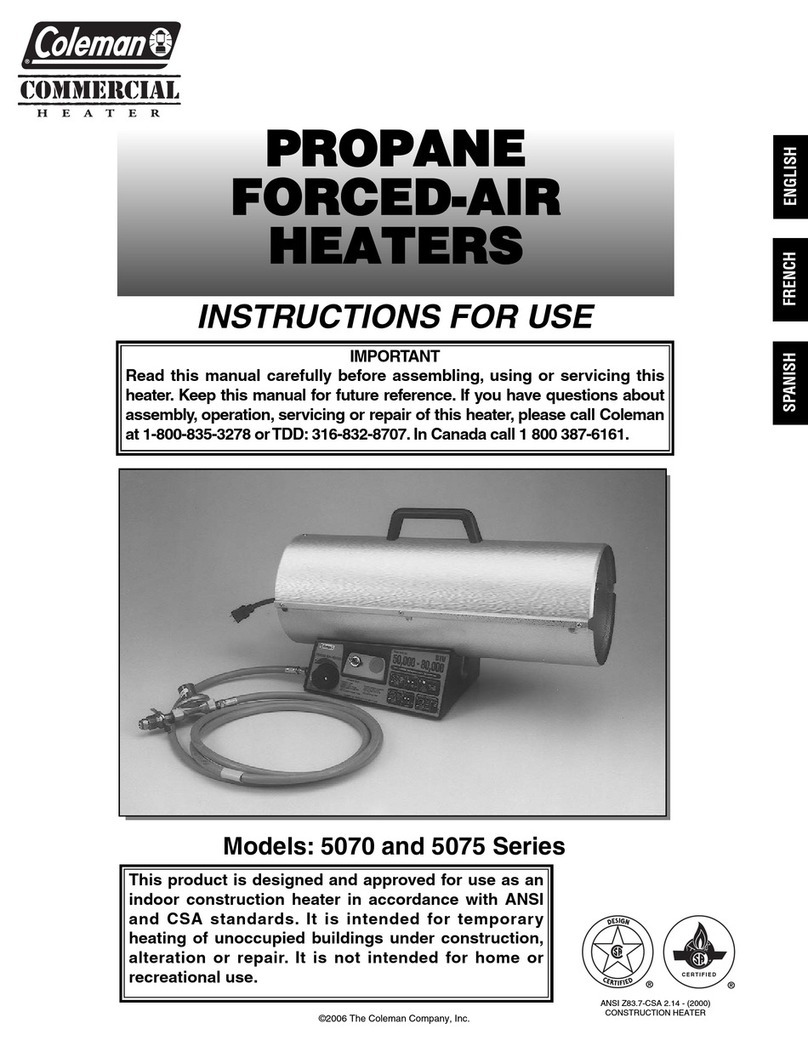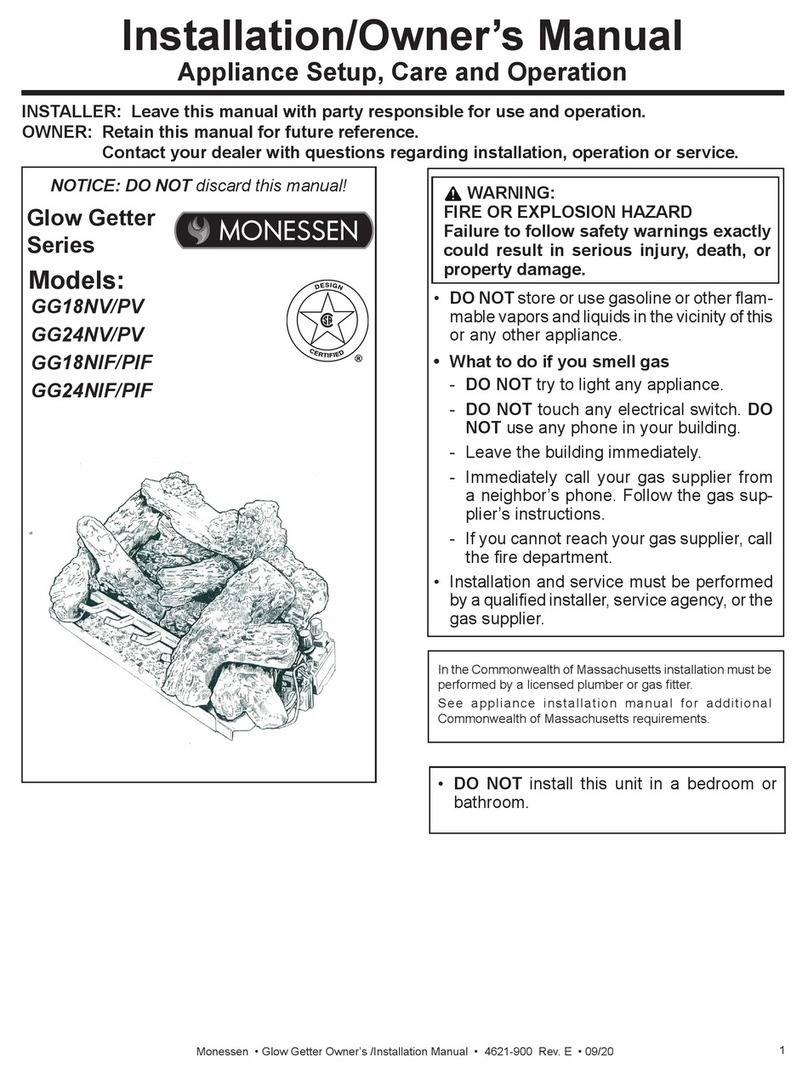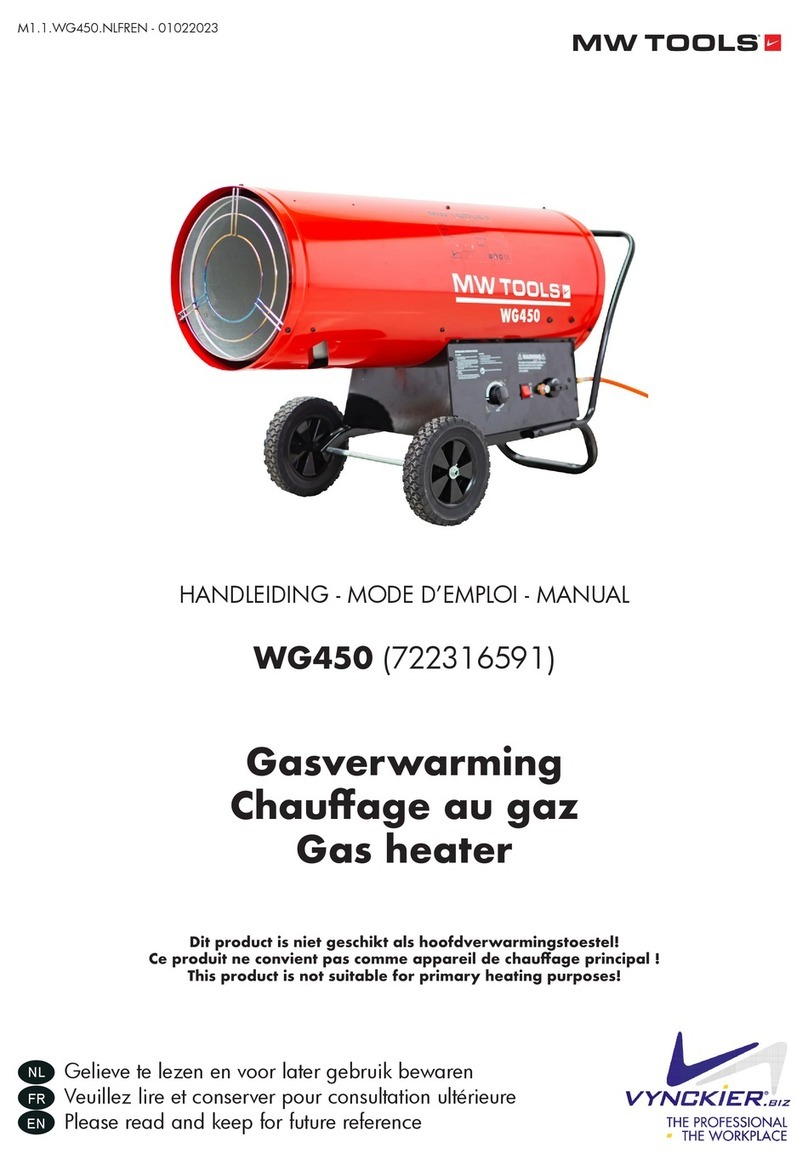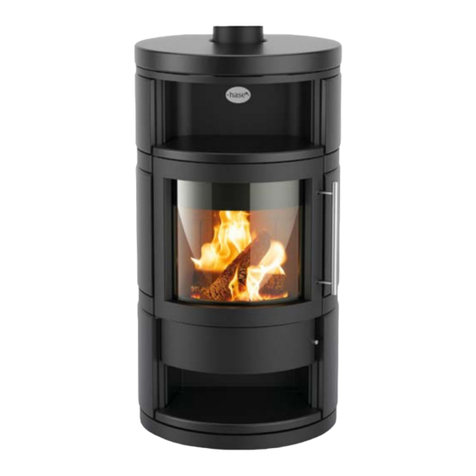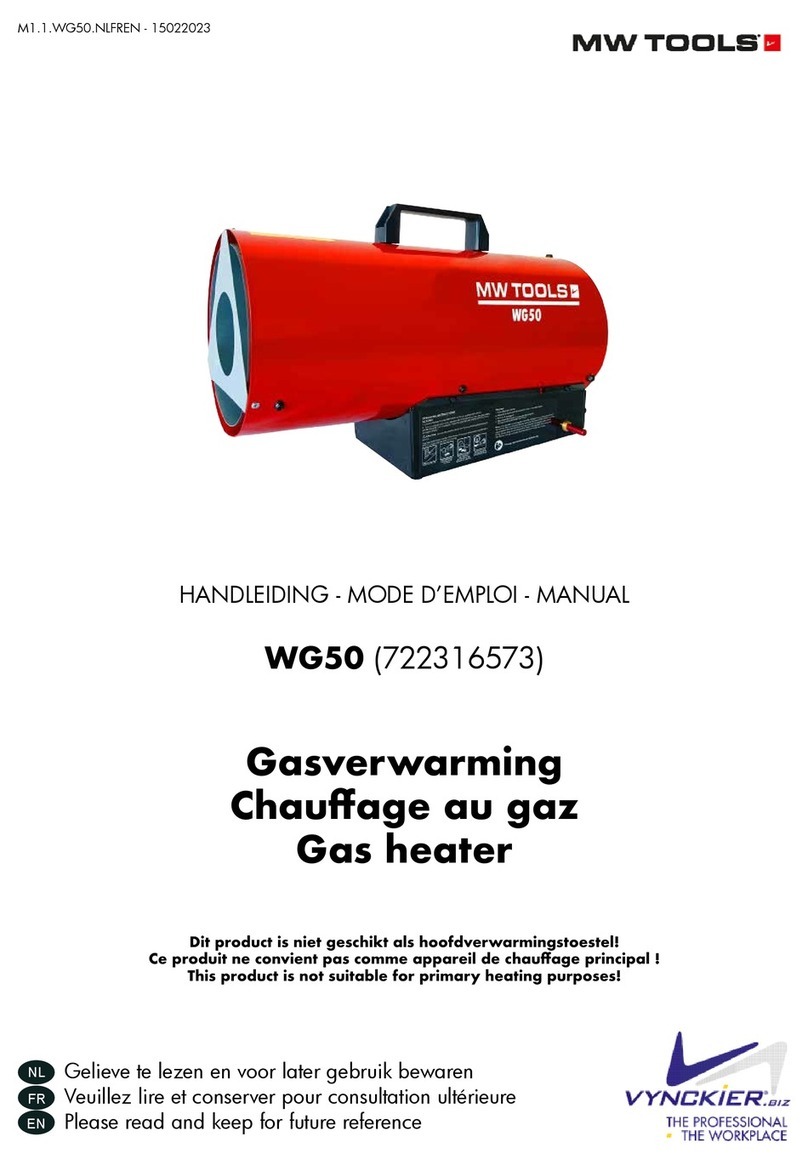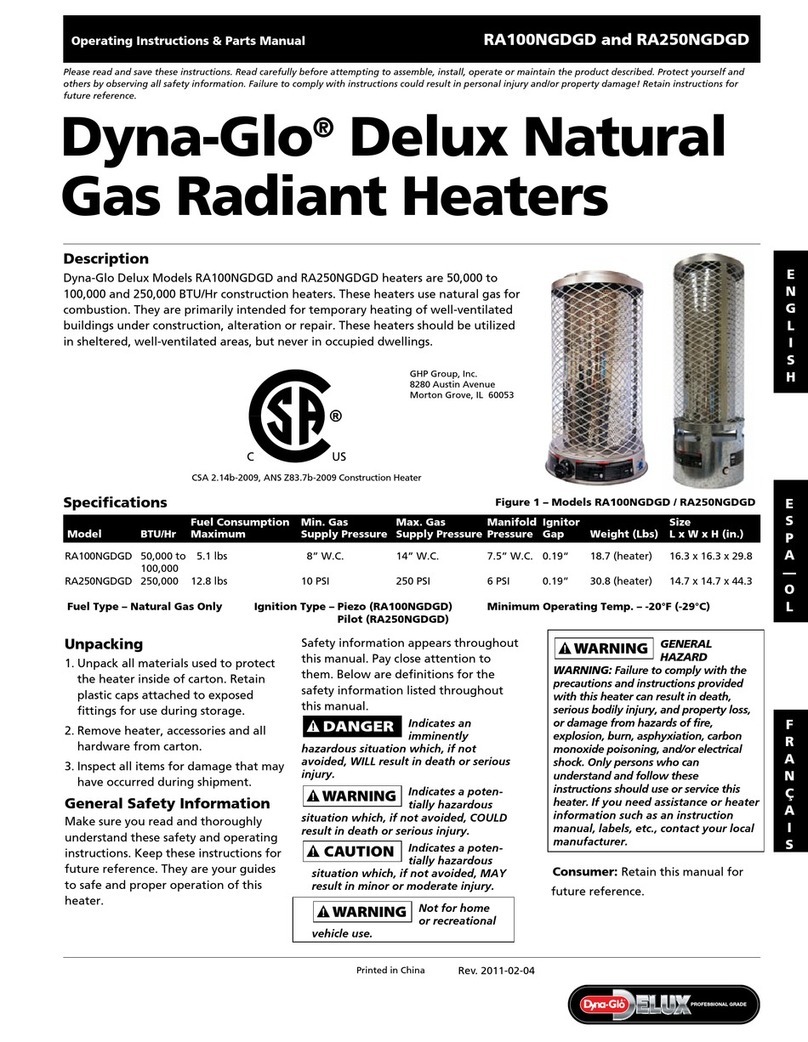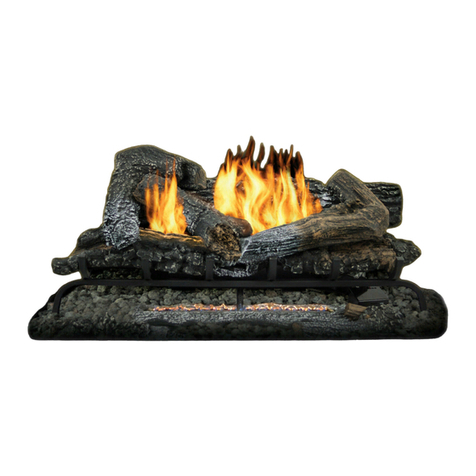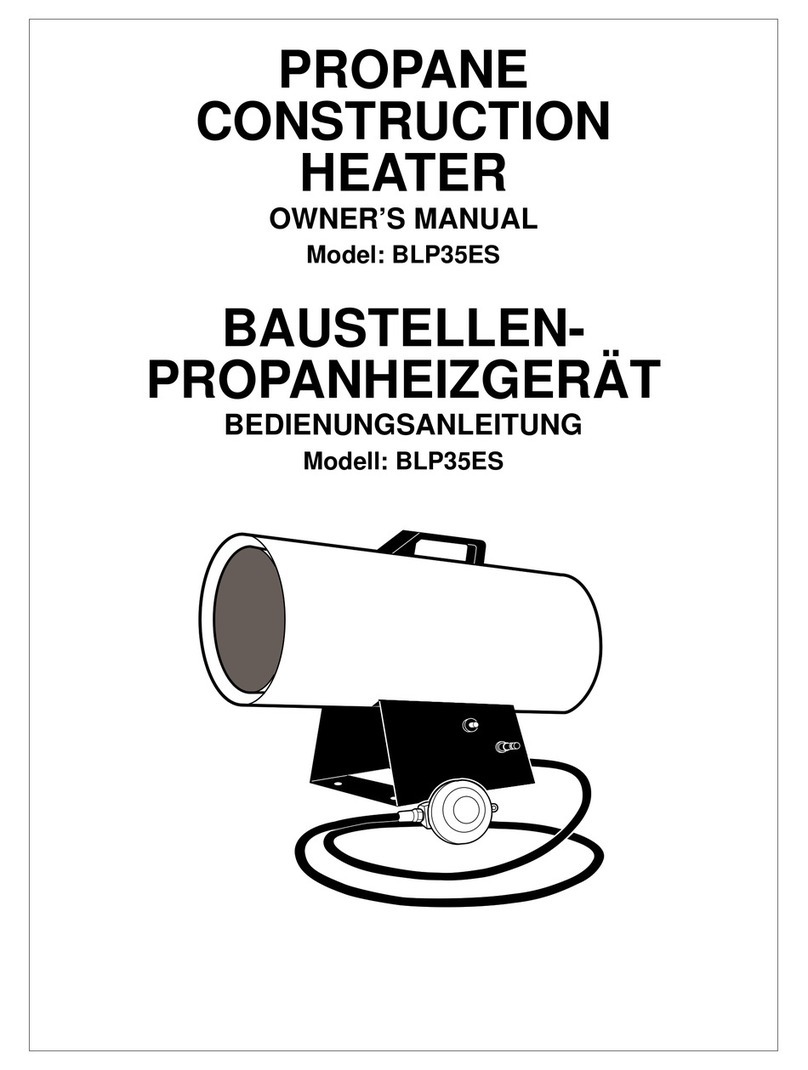Detroit Radiant Products UH Series User manual

Improper installation, adjustment, alteration, service, or maintenance can cause
property damage, serious injury, or death. Read and understand the installation,
operating, and maintenance instruction thoroughly before installing or servicing this
equipment.
This heater must be installed and serviced by trained gas installation and service
personnel only. Failure to comply could result in personal injury, asphyxiation, death,
and fire or property damage.
Do not store or use gasoline or other flammable vapors and liquids in the vicinity of
this or any appliance.
Do not use this heater in indoor living or sleeping quarters! Installation of this unit in
a residential indoor living space may result in property damage, serious injury,
asphyxiation, or death.
The UH Series heater is a gas-fired unit heater. This manual provides specific information related to the
UH Series models. All persons involved with the installation, operation, and maintenance of the heater
system must read and understand the information in this manual.
LIOUH-Rev. 05313
Print: 2M-12/15_r11-06/19 (CDS)
Replaces: LIOUH-1M-8/13 (CDS)
Installation, Operation,
Maintenance, and Parts
WARNING
!
INSTALLER: Present this manual to the end user.
Keep these instructions in a clean and dry place for future reference.
Model#: ___________________ Serial #: _________________________
For Your Safety
If you smell gas:
• Open windows.
• Do not touch any electrical switch.
• Extinguish any open flame.
• Do not use any phone in your building.
• Immediately call your gas supplier from a neighbor’s phone.
• Follow the gas supplier’s instructions.
• If you cannot reach your gas supplier, call the fire department.
(located on rating label)
UH Series
Installation Manual

2
UH Series
Contents
1.0 Introduction . . . . . . . . . . . . . . . . . . . . . . . . . . . . . . . . . . . . . . . . . . . . . . . . . . . . . . . . . . . . . . . . . 3
Overview ...................................................................... 3
Heater Components . . . . . . . . . . . . . . . . . . . . . . . . . . . . . . . . . . . . . . . . . . . . . . . . . . . . . . . . . . . . . 3
Initial Installation Considerations and Pre-Checks ...................................... 4
Product Specifications ........................................................... 5
Safety Labels and Their Locations .................................................. 6
2.0 Safety . . ................................................................... 8
Warning Symbols ............................................................... 8
Applications ................................................................... 9
Standards, Certifications, and Government Regulations ................................. 10
Clearances to Combustibles ...................................................... 12
3.0 Installation . . . . . . . . . . . . . . . . . . . . . . . . . . . . . . . . . . . . . . . . . . . . . . . . . . . . . . . . . . . . . . . . . . 13
Louver Installation............................................................... 13
Configuring the Support Brackets................................................... 14
Hanging the Unit Heater .......................................................... 15
Suspending the Unit Using Lag Bolts/Screws . . . . . . . . . . . . . . . . . . . . . . . . . . . . . . . . . . . . . . . . . 15
Suspending the Unit by Threaded Rod............................................... 15
Pre-Configuration for 180° Installation ............................................... 16
Rotated 180° Installation.......................................................... 16
Rotating the Service Access Door Panel Handle ....................................... 17
Recommended Mounting Heights . . . . . . . . . . . . . . . . . . . . . . . . . . . . . . . . . . . . . . . . . . . . . . . . . . 17
Gas Supply Installation Instructions ................................................. 18
Leak Testing ................................................................... 21
Electrical Requirements and Wiring Diagrams ......................................... 22
Internal Wiring Diagrams . . . . . . . . . . . . . . . . . . . . . . . . . . . . . . . . . . . . . . . . . . . . . . . . . . . . . . . . . 22
Field Wiring Supply Voltage ....................................................... 23
Thermostat Connection .......................................................... 25
Thermostat Location ............................................................. 26
Venting ....................................................................... 27
Replacing Existing Equipment . . . . . . . . . . . . . . . . . . . . . . . . . . . . . . . . . . . . . . . . . . . . . . . . . . . . . 27
General Venting Requirements..................................................... 28
Vertical Venting (Category I)....................................................... 30
Horizontal Venting (Category III).................................................... 31
Common Venting (Category I) . . . . . . . . . . . . . . . . . . . . . . . . . . . . . . . . . . . . . . . . . . . . . . . . . . . . . 33
Concentric Venting . . . . . . . . . . . . . . . . . . . . . . . . . . . . . . . . . . . . . . . . . . . . . . . . . . . . . . . . . . . . . . 34
Combustion Air Requirements . . . . . . . . . . . . . . . . . . . . . . . . . . . . . . . . . . . . . . . . . . . . . . . . . . . . . 34
Separated Combustion Systems ................................................... 35
Room Air Combustion Systems . . . . . . . . . . . . . . . . . . . . . . . . . . . . . . . . . . . . . . . . . . . . . . . . . . . . 37
Unit Start-Up (Commissioning)..................................................... 38
Pre-Start Up Checks............................................................. 38
Verify Proper Inlet Pressure ....................................................... 39
Verify Manifold Pressure.......................................................... 40
Prior to leaving the Job Site ....................................................... 41
High Altitude Operation........................................................... 42
4.0 Operation ................................................................... 44
Sequence of Operation........................................................... 44
Shutdown Procedures............................................................ 45
5.0 Troubleshooting Guide ........................................................ 46
6.0 Maintenance................................................................. 50
Limited Warranty Terms and Conditions . . . . . . . . . . . . . . . . . . . . . . . . . . . . . . . . . . . . . . . . . . . . . 51
Heater Assembly Components and Parts List . . . . . . . . . . . . . . . . . . . . . . . . . . . . . . . . . . . . . . . . . 52
Kit Contents ................................................................... 56

3
UH Series
Overview
The intent of this manual is to provide information regarding safety, design guidelines, installation,
operation, and maintenance of the UH Series gas-fired unit heater. You must read and understand the
instructions and all safety warnings before installing the gas-fired unit heater. This manual is property of
the owner, and must stay with the owner or unit after installation is complete.
Heater Components
Prior to installation, verify that the heater’s gas type and voltage (as listed on the rating plate) match
that of your application. Also verify that you have received the entire heater contents included with your
unit. Refer to page 56 for a list of the kit contents for your heater. Materials not included with the unit
(e.g. screws, vent material, threaded rod, etc.) are the responsibility of the installer. Notify your product
representative or the factory of any discrepancy of missing items prior to installing the unit.
Figure 1.1 •Heater Subcomponents
1.0 Introduction •Overview •Heater Components
1.0 Introduction
Flame Sensor
Louvers
Gas Valve
High Limit
Switch
Spark Igniter
Direct Spark
Igniter Board
Flame
Rollout
Switches
Draft
Inducer
Pressure
Switch
Control
Transformer

4
UH Series
Initial Installation Considerations and Pre-Checks
Placement of the heater is influenced by many factors. Aside from safety factors, considerations for
the general space and heating requirements, availability of gas and electrical supply, and proximity of
possible vent locations are a few examples of factors that should all be considered.
Inspect and evaluate the location of the heater to ensure that the structural support is adequate to
support the unit’s weight. The unit must be installed in a horizontally level position to ensure proper
operation. To reduce noise attenuation along the structure caused by vibration of the unit, the heater
should be installed within 15 feet of a primary building support. In the cases where this installation is
not practical or feasible, the use of spring vibration isolators may be used, so long as they are rated for
use of the unit’s weight (see Chart 1.1).
Adequate space around the heater must also be considered in order to maintain the published
minimum clearance to combustibles and recommended service clearances.
When designing a unit heater system, consider the following:
• Has the building’s heat loss been evaluated?
• Does the design meet the needs of the space?
• Have the recommended mounting heights been observed?
WARNING
!
Improper installation, adjustment, alteration, service, or maintenance can cause
property damage, serious injury, or death. Read and understand the installation,
operating, and maintenance instructions thoroughly before installing or servicing this
equipment. Only a trained, qualified installation or service personnel may install or
service this equipment.
WARNING
!
Do not locate any gas-fired units in area where chlorinated, halogenated, or acid vapors are
present in the atmosphere. These substances can cause premature heat exchanger failure due
to corrosion which can cause property damage, serious injury, or death.
1.0 Introduction •Initial Considerations and Pre-Checks

5
UH Series
Product Specifications
The UH Series unit heater is a single input warm air heater with an average thermal efficiency of 80%,
unless otherwise indicated on the rating label. All units are to be supplied with single-phase 60 Hz
120VAC power. The exterior of all models are finished with industrial-grade colored enamel. For specific
information on each model, see Chart 1.1, below.
Chart 1.1 • Specifications
* Recommended mounting heights are provided as a guideline. Actual conditions may dictate variations
from the above data. Clearance to combustibles must always be maintained.
Figure 1.2 •Dimensional Data (see Chart 1.1 for Physical Dimensions)
Model Number
Cabinet Number
Gas Type
BTU/h Input
BTU/h Output
Physical
Dimensions
Standard Weight
Recommended
Mounting Height*
Gas Connection
Vent Connection
Inlet Connection
Axial Fan Rotation
Primary Voltage
Thermostat
Voltage
UH-30 1Nat
or LP 30,000 24,000
28” W
17” D
12” H
68
Lbs. 8'-12' 1/2"
NPT 3” 3” CCW 120
VAC
24
VAC
UH-45 1Nat
or LP 45,000 36,000
28” W
17” D
12” H
68
Lbs. 8'-14' 1/2"
NPT 3” 3” CCW 120
VAC
24
VAC
UH-60 2Nat
or LP 60,000 48,000
28” W
17” D
17” H
88
Lbs. 10'-16' 1/2"
NPT 4” 4” CCW 120
VAC
24
VAC
UH-75 2Nat
or LP 75,000 60,000
28” W
17” D
17” H
88
Lbs. 10'-18' 1/2"
NPT 4” 4” CCW 120
VAC
24
VAC
1.0 Introduction •Product Specifications
D
TOP VIEW REAR VIEW
H
WW

6
UH Series
1.0 Introduction •Safety Labels and Their Locations
Safety Labels and Their Locations
Product safety signs or labels should be replaced by the product user when they are no longer legible.
Contact either your local distributor or product manufacturer for obtaining replacement signs or labels.
Front View
Rear View
F/N: LLUH005
Vent Out
F/N: LLUH004
Air In
Rating Label (located inside of panel)
F/N: LLV3EP6 - Gas Valve and
Pressure Switch Operation
F/N: LLUH003 - Mounting Notice
DETROIT RADIANT PRODUCTS COMPANY
21400 HOOVER ROAD - WARREN, MI 48089
(586) 756-0950 - www.drp-co.com
MODEL NUMBER
NUMÉRO DE MODÈLE
SERIAL NUMBER
NUMÉRO DE SÉRIE
FOR COMMERCIAL / INDUSTRIAL USE.
FOR INDOOR USE ONLY.
MADE IN U.S.A.
SEPARATED COMBUSTION SYSTEM UNIT HEATER
VERSION
HEAT INPUT
DEBIT CALORIFIQUE
HEAT OUTPUT
REDENMENT
VENT CATAGORY
ÉVENT CATÉGORIE
TYPE OF GAS
TYPE DE GAZ
BTU/h
BTU/h
VOLTAGE
AMPS
PHASE
FREQUENCY
Hz
VAC
MANIFOLD PRESSURE
PRESSION A LA TUBULURE D'ALIMENTATION
MAXIMUM INLET PRESSURE
PRESSION D'ALIMENTATION MAXIMALE
MINIMUM INLET PRESSURE FOR PURPOSE OF ADJ.
PRESSION D'ALIMENTATION EN GAS MIN. ADMISE
INCHES W.C.
INCHES W.C.
INCHES W.C.
THIS DESIGN COMPLIES WITH UNIT HEATER STANDARD:
AÉROTHERME À SYSTÈME DE COMBUSTION ISOLÉ
MINIMUM CLEARANCE TO COMBUSTIBLE MATERIAL
DÉGAGEMENT MINIMUM POUR MATIÉRES COMBUSIBLES
TOP
HAUT
INCH
RIGHT SIDE
COTÉ DROIT
LEFT SIDE
COTÉ GOUCHE
VENT CONNECTOR
CONNECTEUR D'AERATION
SERVICE ACCESS
COTÉ ACCÉDEZ
INCH INCH INCH INCH
ORIFICE SIZE
DIM DE L'INJECTEUR
D.M.S. D.M.S.
NATURAL GAS PROPANE GAS
BOTTOM
BAS
INCH
LABEL REVISION
UH-30N YYMMREPCSHIPPE#### 09/12
30,000
24,000
CATAGORY III
NATURAL
2.4
SINGLE
60
1203.5
14.0
5.0
ANSI Z83.8b-2006 • CSA2.6B-2006 UNIT HEATER
1 1 1 6 18
49 57
1
A
SAMPLE

7
UH Series 1.0 Introduction • Safety Labels and Their Locations
Service Access Door View
(Inside View)
F/N: LLWUH001 - Wiring Diagram
F/N: LLUHCL001c
For Your Safety
F/N: LLUH006c
UH Vent Length Notice
F/N: LLUH001 - LED Status
LLUH001-1M-01/19(CDS)
UnitedTechnologies Circuit Board
# of Flashes GREEN LED STATUS/ ERROR
STEADYOFF Internal Control Fault or No Power
STEADYON Normal Operation, No Call for Heat
FASTFLASH NormalOperation, Call for Heat Present
1 Pressure Switch Open with Inducer ON
2 Pressure Switch Closed with Inducer OFF
3 Limit Switch is OPEN
4 FailedIgnitions, Flame Losses, or ReversedPolarity
5 TwinCommunications Fault
6 Limit SwitchTripped 5 Times During Heat Cycle
7 5Flame Losses During One Heat Cycle
# of Flashes AMBERLED STATUS / ERROR
FASTFLASH Flame Present With Gas ValveOff
STEADYON Flameis Sensed
SLOWFLASH Weak Flame Sense Signal
Fenwal Circuit Board
# of Flashes GREEN LED STATUS/ ERROR
SLOWFLASH Normal Operation - No Call for Heat
FASTFLASH Normal Operation - Call for Heat
2 Ignition Lockout - No Flame Detected
3 Airflow Fault - Pressure Switch Open or Closed
4 High Limit or Rollout Switch Open
5 Flame Sense Error - GasValve Not Energized
STEADYON Internal Control Failure
# of Flashes AMBERLED STATUS / ERROR
OFF Flame Signal is Below Required Level / No Flame Present
STEADYON Flame is Sensed
Each of the followingstatus codes is deter mined bythe number of flashes on the status light. See the Manual for additional information.
Status LED
LLUH001-1M-01/19 (CDS)
United Technologies Circuit Board
# of Flashes GREEN LED STATUS / ERROR
STEADY OFF Internal Control Fault or No Power
STEADY ON Normal Operation, No Call for Heat
FAST FLASH Normal Operation, Call for Heat Present
1 Pressure Switch Open with Inducer ON
2 Pressure Switch Closed with Inducer OFF
3 Limit Switch is OPEN
4 Failed Ignitions, Flame Losses, or Reversed Polarity
5 Twin Communications Fault
6 Limit Switch Tripped 5 Times During Heat Cycle
7 5 Flame Losses During One Heat Cycle
# of Flashes AMBER LED STATUS / ERROR
FAST FLASH Flame Present With Gas Valve Off
STEADY ON Flame is Sensed
SLOW FLASH Weak Flame Sense Signal
Fenwal Circuit Board
# of Flashes GREEN LED STATUS / ERROR
SLOW FLASH Normal Operation - No Call for Heat
FAST FLASH Normal Operation - Call for Heat
2 Ignition Lockout - No Flame Detected
3 Airflow Fault - Pressure Switch Open or Closed
4 High Limit or Rollout Switch Open
5 Flame Sense Error - Gas Valve Not Energized
STEADY ON Internal Control Failure
# of Flashes AMBER LED STATUS / ERROR
OFF Flame Signal is Below Required Level / No Flame Present
STEADY ON Flame is Sensed
Each of the following status codes is determined by the number of flashes on the status light. See the Manual for additional information.
Status LED

8
UH Series
Read and understand all safety information and warnings in this manual prior to installation, operation,
and maintenance of this unit heater. Warnings indicate a potentially hazardous situation which, if not
avoided, could result in death or injury.
Warning Symbols
Safety is the most important consideration during installation, operation and maintenance of the unit
heater. You will see the following symbols and signal words when there is a hazard related to safety or
property damage.
Warning indicates a potentially hazardous
situation which, if not avoided, could result in
death or injury.
Caution indicates a potentially hazardous
situation which, if not avoided, could result in
minor or moderate injury.
Notice indicates a potentially hazardous
situation which, if not avoided, could result in
property damage.
2.0 Safety •Warning Symbols
2.0 Safety
WARNING
!
Improper installation, adjustment, alteration, service, or maintenance can cause property
damage, serious injury, or death. Read and understand the installation, operating, and
maintenance instructions thoroughly before installing or servicing this equipment. Only
trained qualified gas installation and service personnel may install or service this
equipment.
NOTICE
CAUTION
!
!

9
UH Series
Applications
This is not an explosion proof heater. This heater may not be used in a Class 1 or Class 2 Explosive
Environment. Consult your local fire marshal, insurance carrier, and other authorities for approval if the
proposed installation is in question.
Residential Garages
The UH Series unit heater is designed and approved for use in residential garage applications or
non-confined living space applications. If installed in a residential application, the unit must be installed
higher than 18 inches above the finished floor when measuring from the bottom of the unit. In addition,
the heater must be located or protected to avoid physical damage by vehicles.
Commercial / Industrial
The UH Series unit heater is designed and certified for use in industrial and commercial buildings, such
as warehouses, manufacturing plants, aircraft hangars, and vehicle maintenance shops. For maximum
safety, the building must be evaluated for potential problems before installing the heater system. This
unit is certified for use as furnished by the manufacturer. Do not alter the fan or operate motors at a
reduced speed.
Installation of restrictive devices to the inlet or outlet of the fan motor may result in premature
failure of the exchanger pipe, overheating of the appliance, or damage to the components. Do
not attach ductwork, air filters, or poly-tubes to any UH Series unit heater.
CAUTION
!
WARNING
!
This unit is not to be used as a central heating furnace. This unit is not
designed for connecting to a ductwork system. Installing restrictive devices of
the inlet or outlet air discharge may result in premature failure of the
exchanger pipe, overheating of the appliance, or damage to the components.
2.0 Safety •Applications

10
UH Series
2.0 Safety •Standards, Certifications, and Government Regulations
Building
Type Codes and Guidelines
Public
Garages
Installation of this heater in public garages must conform to the following codes:
United States: Standard for Parking Structures NFPA 88A (latest edition) or the
Code for Motor Fuel Dispensing Facilities and Repair Garages
NFPA 30A (latest edition).
Canada: Refer to CAN/CGA B149.1: Installation Codes for Gas Burning Appliances
and applicable Standards for Public Garages.
Guidelines:
• Heaters must not be installed less than 8 ft. (2.4 m) above the floor. Minimum
clearances to combustibles must be maintained from vehicles parked below the
heater.
• When installed over hoists, minimum clearances to combustibles must be
maintained from the upper most point of objects on the hoist.
Aircraft
Hangars
Installation of this heater in aircraft hangars must be in accordance with the following
codes:
United States: Refer to Standard for Aircraft Hangars, ANSI/NFPA 409
(latest edition).
In Canada: Refer to Standard CAN/CGA B149.1 and applicable Standards for
Aircraft Hangars.
Guidelines:
• In aircraft storage and servicing areas, heaters shall be installed at least 10 ft. (3 m)
from above the upper surface of wings or of the engine enclosures of the highest
aircraft that may be housed in the hangar. The measurement shall be made from
the wing or engine enclosure, whichever is higher from the floor, to the bottom of
the heater.
• In areas adjoining the aircraft storage area (e.g., shops, offices) the bottom of
heaters shall be installed no less than 8 ft. (2.4 m) above the floor.
• Suspended or elevated heaters shall be located in spaces where they shall not be
subject to damage by aircraft, cranes, movable scaffolding or other objects.
Provisions shall be made to assure accessibility to suspended heaters for recurrent
maintenance purposes.
Standards, Certifications, and Government Regulations
Installation of this gas-fired heater must conform with all applicable local, state, and national
specifications, regulations, and building codes. Contact the local building inspector and/or fire marshal
for guidance.
In the absence of local codes, the installation must conform to the latest edition of:
United States: National Fuel Gas Code, ANSI Z223.1 (NFPA 54).
Canada: CAN/CGA B149.1 and .2, Canadian Electrical Code C22.1
Copies of these Standards can be viewed or purchased at www.nfpa.org or www.scc.ca.
Chart 2.1 • Standard and Code Installation Guidelines • Building Type

11
UH Series
Chart 2.2 • Standard and Code Installation Guidelines • Building Location
Chart 2.3 • Standard and Code Installation Guidelines • Building Aspect
Applicable authorities governing the manufacturing or installation of this unit here include (but are not
limited to) the following organizations:
In the United States:
• NFPA 54 / ANSI Z223.1 – National Fuel Gas Code.
• ANSI Z83.8 / CSA 2.6 – Gas Unit Heater Construction Standard.
• ANSI/NFPA 70 - National Electric Code.
In the Canada:
• CAN/CGA B149.1-10 – Natural Gas and Propane Installation Code.
• ANSI Z83.8 / CSA 2.6 – Gas Unit Heater Construction Standard.
• C22.1 Part 1 – Canadian Electrical Code.
Building
Location Guidelines
High
Altitude
Guidelines
Installation of this heater is approved, without modifications, for elevations up to 2,000
feet (610 m) above MSL (sea level) in the United States. For elevations above 2,000
feet, the heater input must be derated. See page 41 for details on how to derate.
The type of gas appearing on the nameplate must be the type of gas used. Installation
must comply with national and local codes and requirements of the local gas company.
Non-
Standard
BTU Gas
Guidelines:
Unless otherwise noted on the rating plate, this heater is designed and orificed to
operate on standard BTU gas. Contact the factory if utilizing non-standard BTU gas.
Building
Aspect Codes and Guidelines
Electrical The heater must be electrically grounded in accordance with the following codes:
United States: Refer to National Electrical Code®, ANSI/NFPA 70 (latest edition).
Wiring must conform to the latest edition of National Electrical
Code®, local ordinances, and any special diagrams furnished.
Canada: Refer to Canadian Electrical Code CSA C22.1 Part 1 (latest
edition).
Venting Venting must be installed in accordance with the requirements within this manual and
the following codes:
United States: Refer to NFPA 54/ANSI Z223.1 (latest edition), National Fuel
Gas Code.
Canada: Refer to CAN/CGA B149.1 Installation Codes for Gas Burning
Appliances.
2.0 Safety •Standards, Certifications, and Government Regulations

12
UH Series
Clearances to Combustibles
Clearance to combustibles is defined as the minimum distance that must exist between the specified
feature of the heater, and any combustible items. It also pertains to the distance that must be
maintained from moving objects around the unit heater. A recommended service clearance is defined
as the minimum distance that is needed to properly service the heater. When installing the unit heater,
clearances to combustible for the model heater must be maintained. Refer to Chart 2.4 to determine the
required distances for your model.
Chart 2.4 • Clearances to Combustible Materials (in Inches) Residential Models
Figure 2.1 •Clearances to Combustibles Diagram
2.0 Safety •Clearances to Combustibles
Unit Side Front
Top and
Bottom
Access
Side
Non-Access
Side Rear
Vent
Connection
Clearance to Combustibles 60 118 1 1 6
Clearance to Allow Service 60 118 118 6
FRONT VIEW
Access
Side
Non-Access
Side
Top
Bottom
Vent
Connection
Rear Front
Top
Bottom
SIDE VIEW
Placement of explosive objects, flammable objects, liquids, and vapors
close to the heater may result in explosion, fire, property damage,
serious injury, or death. Do not store or use explosive objects, liquids,
or vapor in the vicinity the heater.
WARNING
!

13
UH Series 3.0 Installation •Louver Installation
3.0 Installation
Louver Installation
For 0° Mounting:
1Guide the plunger side of the louver into the larger of the two holes (as shown in Figure 3.1). The
louver arch must face up.
2When the plunger is in the hole, press the louver in collapsing the internal spring of the plunger.
3Guide the other side of the louver into place by aligning the indexing winglet into place (as shown in
Figure 3.2).
4Repeat steps 1 through 3 above until all louvers are in place.
5Adjust pitch of louvers to give the desired direction of air flow.
For 180° Mounting:
1Drill all of the 0.10” holes on panel “A” with an 1/8” drill bit as indicated in Figure 3.3.
2Guide the plunger side of the louver into the larger of the two holes (as shown in Figure 3.1). The
louver arch must face up.
3When the plunger is in the hole, press the louver in collapsing the internal spring of the plunger.
4Guide the other side of the louver into place by aligning the indexing winglet into place (as shown in
Figure 3.2).
5Repeat steps 1 through 3 above until all louvers are in place.
6Adjust pitch of louvers to give the desired direction of air flow.
Figure 3.1 •Louver Installation
Panel “A”
Hole to be
drilled
Figure 3.3 •Louver Installation
Figure 3.2 •Louver Installation

14
UH Series
3.0 Installation •Configuring the Support Brackets
Sheet Metal
Screws
Mounting
Bracket
Mounting
Bracket
High humidity or saltwater atmospheres will accelerate heater corrosion and reduce useful life. Do not
install the heater in locations where water (in the form of rain, drips, or spray) could fall onto the gas
ignition components.
Once all the louvers have been installed, the unit may be installed as shown in Figure 3.6 or inverted
180° depending on the desired location as governed by clearances, vent connection locations, air
direction, gas supply, electrical supply, and service accessibility. The standard installation is installed
how it was factory configured, with the controls on the left side of the heater (when looking at the front).
Configuring the Support Brackets
Standard Installation (Control Panel is on the Left Side)
1For standard control access, remove the four (4) #10 sheet metal screws and mounting bracket
along the top edge of both the front and back of the unit.
2Install the front bracket as shown in Figure 3.4 by aligning the screw holes on the bracket with the
screw holes on top of the edge of the unit.
3Repeat this process for the opposite bracket on the back panel.
Figure 3.4 •Support Brackets
WARNING
!
Improper suspension of the unit heater may result in collapse and being crushed.
Always suspend from a permanent part of the building structure that can evenly
support the total force and weight of the heater.
Failure to maintain minimum clearance to combustibles may result in fire and/ or
explosion, property damage, serious injury, or death. Always maintain minimum
clearances.
NOTICE

15
UH Series
Hanging the Unit Heater
To ensure proper operation, the heater must be installed in a level horizontal position. The units are
designed to be hung from the brackets (supplied) and must be field configured prior to hanging the unit.
The mechanism that suspends the heater from the brackets (e.g. lag screws, threaded rod, or threaded
pipe) must be adequate to support the weight of the unit (see page 5 for unit weights).
Suspending the Unit Using Lag Bolts/Screws
1Determine the desired mounting points, and mark the locations for reference.
2Using the hole spacing diagram (Figure 3.5), mark and prepare the structure mounting surface. If
necessary, weld blocks, drill holes, or install additional bracketing or steel channel.
NOTE: When bolting the unit directly to a wood truss, the recommended hardware is ¼”x 1-1/2”
(minimum) lag bolts with ½” washers. The unit must be supported by a minimum of four (4)
suspension points. Brackets are slotted to accommodate joists on 16 inch or 24 inch centers.
3Raise the unit heater to the mounting location and secure it to the building structure using the
selected hardware. Ensure that the lag bolts are not stripped and are properly bearing the load of
the unit heater.
1 inch angle mounting brackets are slotted to accommodate joists on 16 inch or 24 inch center lines.
Figure 3.5 •Mounting Bracket Hole Spacing Diagram (in Inches)
Suspending the Unit by Threaded Rod
1Determine the desired mounting points, and mark the locations for reference.
2Using the hole spacing diagram (Figure 3.5) mark and prepare the structure mounting surface. If
necessary, weld blocks, drill holes, or install additional bracketing or steel channel.
NOTE: The recommended hardware is 3/8”–16 threaded rod. The unit must be supported by a
minimum of four (4) suspension points.
3Fasten beam clamp, screw hook, turnbuckle, steel channel, or other anchoring device to the
suspension points.
4Determine the desired mounting height. Cut four Pieces of 3/8” -16 threaded rod of equal length in
which the heater will be hung. Ensure that the threads are not damaged during the cutting process.
5Attach the threaded rod to the unit mounting brackets, securing with a top and bottom nut. A lock
washer is preferred, or a secondary jam nut may also be used.
3.0 Installation •Hanging Heater •Suspending Unit with Lag Bolts/Screws or Threaded Rod
0.50
7. 6 0
6.03
4.45
2.88
1.30
12.33
18.63
17. 0 6
15.73
13.91
20.21
.00
21.78
23.36
24.93
25.73
10.50
9.18
.00
0.45
0.54

16
UH Series
3.0 Installation •Rotated 180° Installation
6Attach threaded rod to prepared anchoring device. Adjust the threaded rod until the unit is level and
equal weight distribution is achieved. The threaded rod must be perpendicular with the unit heater.
Do not install threaded rods at an angle, as this can result in weakened structural integrity or undue
noise.
Figure 3.6 •Threaded Rod Support - Rear View
Pre-Configurations for 180° Installation
Prior to installing the heater in an inverted position of 180° from the standard configuration, a few items
must be configured to accommodate this installation.
Rotated 180° Installation (Control Panel is on the Right side)
1For 180° installations, remove the four (4) #10 sheet metal screws and mounting brackets along
the top edge of both the front and back of the unit.
2Reinstall the screws into the panel, without attaching the brackets.
3Along the opposite edge, remove the four (4) corresponding #10 sheet metal screws and affix the
brackets to the unit (the side that was originally the bottom now becomes the top.)
4Proceed with suspending the unit normally as described here in the manual.
Support Rods

17
UH Series 3.0 Installation •Rotating the Service Door Handle • Recommended Mounting Heights
Rotating the Service Access Door Panel Handle
1Remove and retain screws securing the service access door.
2Remove the two (2) screws holding the handle in place, and rotate the handle 180°. Secure
handle in new position with retained screws.
3Reinstall the service access door, positioning the sight glass in line with the burners. The
handle should now taper up towards the new top of the unit.
Recommended Mounting Heights
Chart 3.1 •Recommended Mounting Heights*
* Recommended mounting heights are provided as a guideline. Actual conditions may dictate
variations from the above data. Clearance to combustibles must always be maintained.
The recommended mounting heights of the units are critical to its performance. Refer to the Chart 3.1
for specific recommended mounting heights. The mounting height is measured from the finished floor to
the bottom of the unit. Units that are mounted higher than the recommended mounting heights may not
directly deliver heated air to the floor level.
Model
Typical
Mounting Height
Approximate
Heat Throw
Average Air
Temperature Rise
UH-30 8 to 12 Ft. 26 Ft. 45°F
UH-45 8 to 14 Ft. 28 Ft. 45°F
UH-60 10 to 16 Ft. 37 Ft. 45°F
UH-75 10 to 18 Ft. 39 Ft. 45°F

18
UH Series
Gas Supply Installation Instructions
The gas supply to the unit heater must be connected and tested in accordance with national, state,
provincial, and local codes along with guidelines in this manual. In the United States refer to the latest
edition of the ANSI Z223.1 (NFPA54) Standard and in Canada refer to the latest edition of the CAN/
GCA B149.1 Standard.
Supply gas piping to the unit should conform with the local and national requirements for type and
volume of gas handled, and pressure drop allowed in the line. Avoid pipe sizes smaller than 1/2”.
3.0 Installation •Gas Supply Installation Instructions
WARNING
!
Improperly connected gas lines may result in serious injury and death,
explosion, poisonous fumes, toxic gases, or asphyxiation. Connect gas lines
in accordance to national, state, provincial, and local codes.
Gas pressure to the appliance controls must never exceed ½” PSI (14” W.C.). Damage to the
controls may result.
Gas lines should be purged of air as described in ANSI Z223.1 (NFPA 54) or CSA-B149.1– latest
version. Installation of the piping must also conform with the local building codes, or in the
absence of local codes, with the latest edition of the National Fuel Gas Code (NFPA 54). In
Canada, installation must be in accordance with CSA-B149.1
CAUTION
!
NOTICE
The total input to the appliance must fall within +/- 5% of the rated input as indicated on the
rating plate. Otherwise the heat exchanger may prematurely fail.

19
UH Series
Refer to Chart 3.2 for natural gas and Chart 3.3 for propane to determine the cubic feet per hour (CFH)
required for the type of gas and size of unit to be installed. To determine the proper pipe diameter, use
the CFH value and the length of pipe necessary from Chart 3.4. In the case where several units are
serviced by the same main gas line, the total capacity (CFH) and length of main must be adequate to
service all appliances downstream of this main.
Chart 3.2 •Natural Gas Consumption
*Assumes an average heating value of 1050 BTU/SCF and a Specific Gravity of 0.60.
Chart 3.3 •Propane Gas Consumption
*Assumes an average heating value of 2500 BTU/SCF and a Specific Gravity of 1.53.
Chart 3.4 allows for a 0.3 inch W.C. pressure drop in the supply pressure from the building main to the
inlet of the unit. Refer to the chart for the appropriate range of inlet pressures for each gas type. When
sizing the inlet gas pipe diameter, make sure that the unit supply pressure can be met after the 0.3 inch
W.C. pressure drop has been subtracted from the main pressure. If the 0.3 inch W.C. pressure drop is
too high, refer to NFPA 54 or the Gas Engineer’s Handbook for other gas pipe capacities.
3.0 Installation •Gas Supply Installation Instructions
Model
Manifold
Pressure
(Inches W.C.)
Min. Inlet
Pressure
(Inches W.C.)
Max. Inlet
Pressure
(Inches W.C.)
Gas
Consumption
(CFH)*
Gallons
per hour*
Orifice
Size
Number of
Orifices
UH-30P 10.0 11.0 14.0 12.0 0.33 56 DMS 2
UH-45P 10.0 11.0 14.0 18.0 0.49 56 DMS 3
UH-60P 10.0 11.0 14.0 24.0 0.66 56 DMS 4
UH-75P 10.0 11.0 14.0 30.0 0.82 56 DMS 5
Model
Manifold
Pressure
(Inches W.C.)
Min. Inlet
Pressure
(Inches W.C.)
Max. Inlet
Pressure
(Inches W.C.)
Gas
Consumption
(CFH)*
Orifice
Size
Number
of Orifices
UH-30N 3.5 5.0 14.0 28.6 49 DMS 2
UH-45N 3.5 5.0 14.0 42.9 49 DMS 3
UH-60N 3.5 5.0 14.0 57.1 49 DMS 4
UH-75N 3.5 5.0 14.0 71.4 49 DMS 5

20
UH Series
Chart 3.4 •Maximum Capacity for Schedule 40 Metallic pipe, in CFH
The UH Series heater is equipped to receive a gas supply line nipple of ½”NPT Schedule 40 metallic
pipe. All piping must be installed in accordance with the requirements outlined in the National Fuel Gas
Code ANSI/Z223.1 (latest edition) or CSA-B149.1 and B149.2. Support all gas supply piping with pipe
hangers, metal strapping, or other suitable material. Do not rely on the heater to support the gas pipe.
When connecting piping to the unit, the use of a thread joint compound is required. The thread
compound (pipe dope) shall be resistant to the action of liquefied petroleum gas or any other chemical
constituents of the gas to be conducted through the piping. Use of Teflon®tape is not permitted.
Install a ground joint union with a brass seat and a manual shut off valve adjacent the unit for
emergency shut off and easy servicing of controls. A 1/8” NPT plugged tap that is accessible for a test
gauge connections is also recommended, as illustrated in Figure 3.7.
A sediment trap must be installed in the supply line in the lowest spot prior to connecting to the heater.
The trap length shall be at least three inches long. Ideally, the trap would be installed as close as
possible to the shut off, as shown in Figure 3.7.
3.0 Installation •Gas Supply Installation Instructions
Pipe
Length
(feet)
1/2” 3/4” 1” 1-1/4” 1-1/2” 2”
Nat L . P. Nat L . P. Nat L . P. Nat L . P. Nat L . P. Nat L . P.
10’ 132 86 278 182 520 340 1050 686 1600 1046 3050 1993
20’ 92 60 190 124 350 229 730 477 110 0 719 2100 1373
30’ 73 48 152 99 285 186 590 386 890 582 1650 1078
40’ 63 41 130 85 245 160 500 327 760 497 1450 948
50’ 56 37 115 75 215 141 440 288 670 438 1270 830
60’ 50 33 105 69 195 127 400 261 610 399 1150 752
70’ 46 30 96 63 180 118 370 242 560 366 1050 686
80’ 43 28 90 59 170 111 350 229 530 346 990 647
90’ 40 26 84 55 160 105 320 209 490 320 930 608
100’ 38 25 79 52 150 98 305 199 460 301 870 569
125’ 34 22 72 47 130 85 275 180 410 268 780 510
150’ 31 20 64 42 120 78 250 163 380 248 710 464
175’ 28 18 59 39 110 72 225 147 350 229 650 425
200’ 26 17 55 36 100 65 210 137 320 209 610 399
WARNING
!
Always use two (2) opposing wrenches to tighten mating pipe connections
to prevent excessive torque on the gas valve and manifold pipe. Excessive
torque can damage the valve and/or misalign the orifice, resulting in fire,
explosion, serious injury, or death.
This manual suits for next models
8
Table of contents
Other Detroit Radiant Products Gas Heater manuals
Popular Gas Heater manuals by other brands

Primo Water
Primo Water NY-158A use instructions

Dyna-Glo
Dyna-Glo GUH50NE/LE Operating instructions and owner's manual

FMI
FMI Heat Majic FVF18P OWNER'S OPERATION AND INSTALLATION MANUAL

Schwank
Schwank SET - SETU Installation and owner's manual

Vermont Castings
Vermont Castings SDDVTBSSB Installation and operating instructions
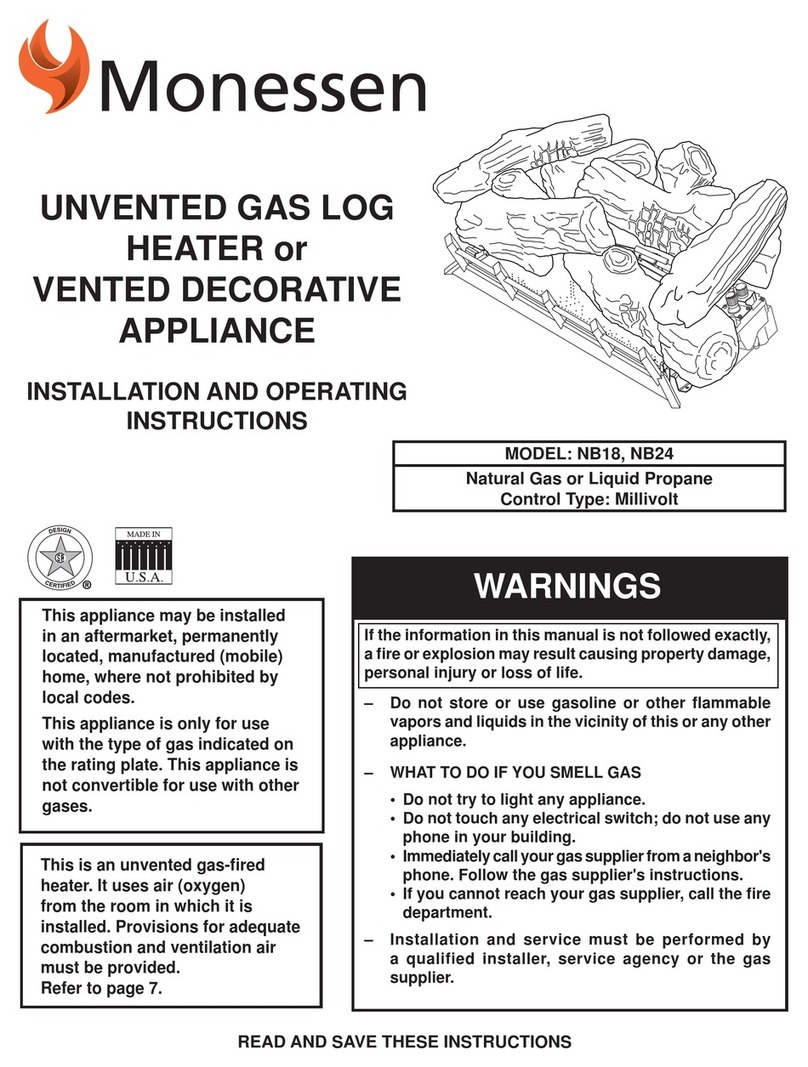
Monessen Hearth
Monessen Hearth NB18 Installation and operating instructions




